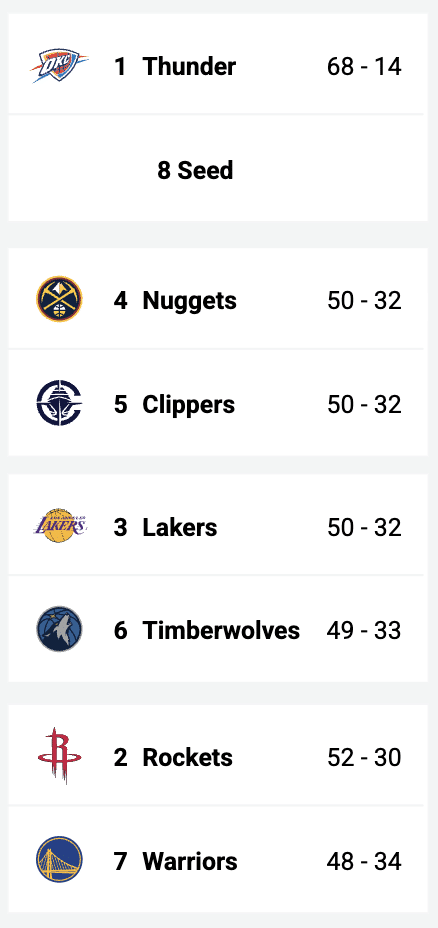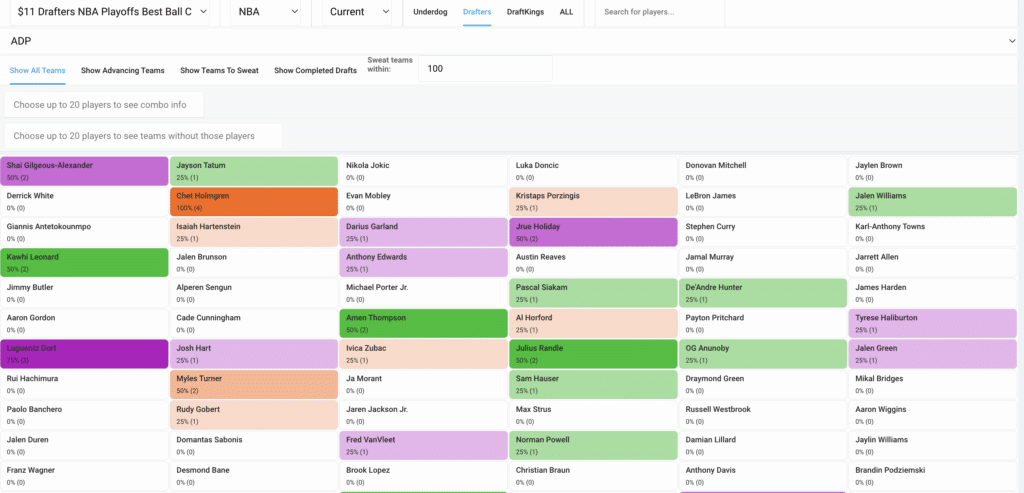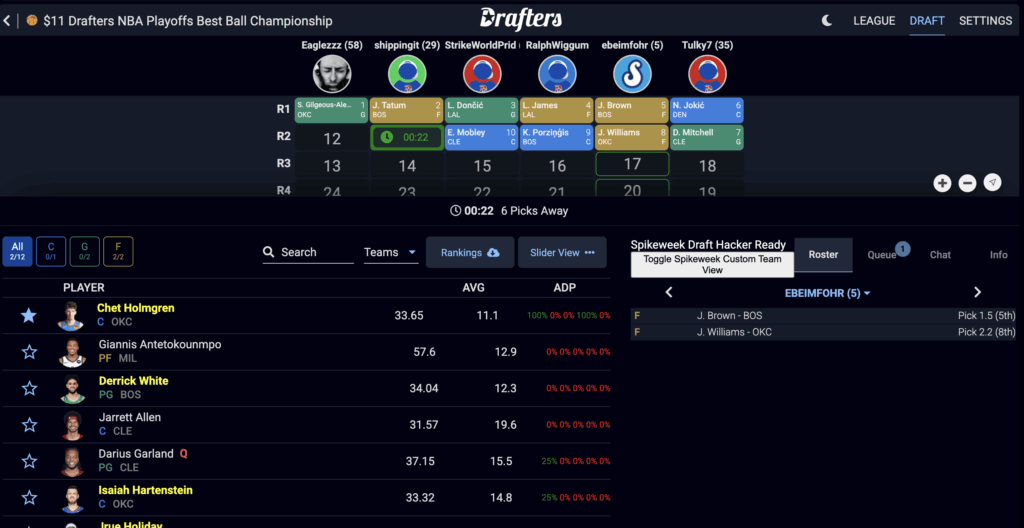NBA Playoff Best Ball on Drafters is a similar, yet unique NBA Playoff Best Ball format that offers some extremely fun strategy. Just like all other sports that Drafters offers, the contests for the NBA Playoffs are cumulative scoring as opposed to the round by round playoff advancement structure on Underdog.
The only other minor differences in the format are as follows:
- 12 Rounds (instead of 10)
- Larger Starting Lineup with different positional breakdown
- 2 Guards
- 2 Forwards
- 1 Center
- 1 Flex
Those unique variables are extremely important, especially when we combine the cumulative nature of the format with the fact you have to fill one more starting lineup spot in each round, as well as 2 guard and 2 forward spots.
But at the end of the day, we do still really want to maximize our exposure to the teams who advance the furthest, or certainly at least win a round and score well. That means we do need to get at least a large portion of the NBA Playoff Bracket correct. You can see my full bracket prediction for this season here.
I also broke down each NBA Playoff team, and how I’m handling my exposure to them, which has similar crossover between both Underdog and Drafters.
But let’s cut to the chase and dive into our strategy for this 2025 tournament.
Drafters NBA Playoff Best Ball Strategy (2025)
2025 brings arguably the most wide open year I can remember in recent NBA Playoff history. The Western Conference in particular has 7 teams that have a truly realistic shot at winding up in the NBA Finals.
But let’s start with the simpler conference – The East.
Eastern Conference Breakdown
Last season, while I loved the Knicks and Pacers to make a run or win a couple of series, there was one team that felt pretty inevitable in making the finals, and that was the Boston Celtics. This season, the Celtics are still an outstanding team, but an actual competitor has emerged – the Cleveland Cavaliers. In fact, the Cavs actually have a 5 game lead on the Celtics in the East, running away with the number one overall seed.

I still believe the Celtics are the favorite to make it out of the East, despite those standings, as they’ve cruised a bit more through this regular season resting some players more frequently. Kristaps Porzingis has only played 39 games. However, the Cavs are a real contender this season. Evan Mobley has taken a very real leap that was necessary for this team to compete with Boston, and Darius Garland is back to his high level play after a near wasted season last year where he never fully recovered from the aftermath of his broken jaw and the weight/strength loss. The Cavs also made a sneaky big trade in acquiring De’Andre Hunter to fill a void on the wing that is wildly important both overall and against this Celtics squad.
The Cavs and Celtics split their season series 2-2, and the Cavs will have the home court advantage in their series, assuming neither team slips up along the way. Last year, basically every team I built was with the assumption that the Celtics would make the finals. Obviously you can’t truly have 100% of teams stacking the Celtics, but that was the overall plan, using the Knicks and Pacers to help push the Celtics through each round when they were likely going to play very few games to help our scoring. But with that home court and their very real improvements, the Cavs have emerged as a second team in the East that I think is truly live to make the finals, and I will be building both Celtics and Cavs teams for the finals in 2025.
I broke down the rest of the East in more detail in the team-by-team breakdown, but there are really no other true finals contenders across the rest of the East, with a very minor caveat. The Knicks and Pacers are absolutely dangerous, and they are my picks to square off with the Cavs and Celtics in the second round. But the Knicks defensive flaws with a point guard/center pairing of Brunson and KAT, and the Pacers defensive issues paired with minor offensive issues against elite playoff defenses like Boston and Cleveland leave these teams just a tad short on the necessary strength to upset the big two. With that said, the Pacers are the one team that I think at least has some life to make a run. We saw them take down both the Bucks (albeit with injuries) and Knicks (also some injuries) en route to the conference finals last year. In those conference finals, they also gave the Celtics more of a series than meets the eye. They were swept, but they lost Tyrese Haliburton for the last 2 games. They took Boston to OT in Game 1, and they were winning both Game 3 and Game 4 (without Haliburton) late in the 4th quarter. They should be better off this season with last year’s experience and some additional growth from their young core. They also beat Boston in 2 of 3 games in the regular season and split with Cleveland in the 2 games with both at full strength. At a minimum, we could definitely see the Pacers be very helpful pieces in the first couple of rounds on Drafters, which count just as much as the final rounds in this format.
The rest of the East is borderline un-draftable in these contests. The Pistons make for slightly appealing round one plays, particularly Cade Cunningham and *maybe* Jalen Duren, but that’s about it. The Bucks are the team that I heard on shows and in comments last season that I was wrong about. I picked them to lose to the Pacers and essentially called them undraftable then as well. With Giannis and the notable names, that’s understandable, but this team is simply too inherently flawed to make a real run. They made a desperate trade (that was also about future cap flexibility) shipping Middleton out for Kyle Kuzma, and Bobby Portis will only just be getting back from suspension for the playoffs. Brook Lopez has fallen off the proverbial age cliff, and we got word Damian Lillard will be out for Game 1 at a minimum, and this team is simply DOA against good teams without a fully healthy Dame, no matter how good Giannis is. The Magic are likely to get swept again the Celtics.
Western Conference
While the East is pretty straightforward (apologies to the Knicks, Pacers, Bucks and Pistons fans), the West could not possibly be more different. First, let’s take a look at bracket:

I broke down my thoughts on every team here, but we should note that at a high level there are several teams who can absolutely make the finals here. With the Warriors winning the Play-In game against the Grizzlies, they avoid the Thunder in the opening round (RIP Grizzlies), and they’re actually favored over the Rockets in the betting market in that series (more on that in a bit).
On one hand, that makes things much more difficult. On the other hand, it might actually make it a bit easier in drafts. The Thunder are the clear favorite, but we have opportunities all throughout the draft to build with players from a variety of teams that are truly live to make a deep run.
Prior to the finalization of the bracket, I was a lot lower on the Rockets, but I actually believe this to be the second best draw they could have gotten, and that’s something we can take advantage of in drafts. I get it, you’re thinking “Erik, this is the Warriors with Steph Curry, Jimmy Butler and Draymond Green!”. But the Rockets defense, athleticism and physicality is a serious problem for the Warriors. They have arguably the single best defender in the NBA for Steph in Amen Thompson, several options for Jimmy Butler, and the Warriors offense actually gets very stuck in the mud when you disrupt Steph given their lack of shooting outside of him. I know it’s a hot take and many will disagree, but I picked (and bet) the Rockets to advance here. I think they present an exploitable opportunity to get a good team that can absolutely win at least their first series at super cheap prices. We’ll get into the positional nuances for Drafters in a bit, but they also happen to have studs at both Forward (Amen) and Center (Sengun), with cheapies (Van Vleet/Brooks at Guard, Eason/Smith Jr. at Forward) available that can be huge for our lineups.
The T’Wolves are also in a matchup where I disagree with the market. Certainly the Lakers can win any series given their trio of Luka/Lebron/Reaves, but I think they are a dreadful matchup for the Lakers. Now that they are at full strength, they have incredible depth and lineup versatility that allows them to make adjustments that the Lakers simply cannot. They have outstanding perimeter defenders to throw at the Lakers trio and their own apex predator on offense in Anthony Edwards. I am not writing the Lakers off by any stretch of the imagination, but we also should be looking for exploitable opportunities (like the Rockets above) where ADP is telling us the market is very one-sided in terms of who they think will win the series, even though the series is actually closer to a coin flip. Minnesota has a ton of options at each position, and they are dirt cheap on Drafters, with only Edwards cracking the top 25 in ADP.
I do think it’s necessary to note that I would call the Thunder the definitive number one team here in the West. They are my pick to come out of the West. They’ve made huge strides both in player development and in adding to the roster since last season. They’re having one of the single most dominant regular seasons of all time, despite key players missing time with injury, and some of those issues they had last year have at a minimum been upgraded, if not resolved. They are not infallible, however, and no matter who they play in each round, their road to the finals is going to be incredibly tough. Either of the Clippers or Nuggets are very dangerous, and while I side with the Clippers in that first round series, I cannot knock anyone for preferring a team with Nikola Jokic.
Positional Nuances
One thing that can easily get overlooked in playoff best ball amidst all the focus on teams and stacking is the nuance of how each position (guard, forward and center on Drafters) breaks out both across the entire player pool but also on each team.
You will see this accounted for in our rankings, but it’s also important to understand heading into your drafts.
For 2025, you’ll notice that the forward position is both the weakest and the trickiest. If you want a Celtics forward, you essentially have to draft Tatum or Brown, both of whom are drafted in the first 6 picks. The Cavs barely have a wing, with just De’Andre Hunter in the middle rounds. The Thunder have just Jalen Williams, who is drafted at an ADP of just under 8. Aaron Wiggins and Max Strus are wings on Underdog, but they are guards on Drafters, further depleting the position for top teams. Mapping out your forward position for the teams you are drafting is one of the most important aspects of these drafts.
In an ideal world, we want to avoid as many one offs as possible. This allows us to give ourselves the opportunity of having as many available players as we can in the later rounds (2nd round, conference finals) to give ourselves a chance to push ahead of the field with a lot of player overlap on top teams at that point. It also takes advantage of the most critical, yet most unpredictable, piece of NBA Playoff Best Ball – games played. We don’t know how many games each of these series will go, but obviously players who play more games are going to score more points. Instead of tossing one off players from a bunch of different teams around our finals matchup, we can correlate as much as possible, and take advantage of when those teams play more games.
Those details are particularly relevant to the positional nuances because we know that foward is weak and difficult to fill for some matchups. The Guard and Big position are quite strong across the player pool, but again certain matchups do run into issues. If you want a Celtics/Thunder finals matchup, you need an early wing, but you also need to understand there are only 4 bigs available on those two teams, two of which are very expensive with the other two in the mid-ish rounds (Hartenstein and Horford). With a Thunder/Celtics finals matchup, you also simply may not be able to fill your second forward spot in the NBA finals unless you prioritize Sam Hauser (and already have one of Tatum, Brown or Williams). These kind of situations are vitally important to know when mapping out your team and player pairings.
These situations do lend more credence to one offs and taking shots on some of these cheaper teams, like the aforementioned Rockets and T’Wolves, but also the Pacers and Knicks. With rounds one and two of the playoffs counting almost as much in terms of our potential winnings as the final rounds, we do need to ensure that we are putting up big scores in those rounds, even if it means sacrificing players on teams that do not advance. The Pacers, for example, did not make the finals last year and even got swept in the conference finals (and Haliburton got hurt!), but they were huge pieces that were absolutely mandatory in competing for the win of last year’s Drafters Playoff tournament. Even some Knicks were valuable, despite only playing two series because they played both a ton of games and a ton of minutes in the first two rounds, putting up big fantasy scores.
Rankings
If you are a Spike Week Premium subscriber, you can view and download our NBA Playoff Best Ball Rankings here. The rankings reflect all of the strategy and texture outlined in this piece, and you also get access to all of our Best Ball Tools (like the Draft Hacker and DraftIQ), Rankings & Strategy for every Best Ball sport and more for one low price of $39.99 per month (or $299.99 per year).
Player and Team Combinations
A critical, but very underrated, aspect of these Playoff Best Ball tournaments is how we combine the players we draft, and the real life NBA teams that we draft. We want to build our portfolio of teams in a way that optimizes these team prediction edges that we’ve outlined above and ideally gives us the right amount of combinations of different finals matchups and different players from within those finals matchups.
If you are a Spike Week subscriber, I mentioned that you get access to our Draft Hacker and DraftIQ tools. Once you’ve drafted some teams, you can view these exact combinatorial details within DraftIQ, our exposure analysis tool. Here are a couple examples in DraftIQ from the Draft Board and Playoff Combos tabs for an easier way to view your Player, Player Combo and Team Combo Exposures:


During your drafts, you can also use the Draft Hacker, our Draft Overlay tool, to view your player exposure and player combinations live in real-time while you draft, directly on your draft screen. You can customize the options that show on your screen during your draft, and this will allow you to see those player combinations or finals matchups that you may want to make sure you have covered or at the exposure level you’re targeting.

If you haven’t yet signed up for Drafters, make sure to use promo code SPIKE for a 100% Deposit Bonus up to $100, and you can also join our Spike Week Discord and hop in the conversation with other super sharp NBA Playoff Best Ball drafters out there talking strategy every day.





